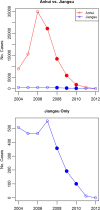Genetic diversity and population structure of Plasmodium vivax in Central China
- PMID: 25008859
- PMCID: PMC4094906
- DOI: 10.1186/1475-2875-13-262
Genetic diversity and population structure of Plasmodium vivax in Central China
Abstract
Background: In Central China the declining incidence of Plasmodium vivax has been interrupted by epidemic expansions and imported cases. The impact of these changes on the local parasite population, and concurrent risks of future resurgence, was assessed.
Methods: Plasmodium vivax isolates collected from Anhui and Jiangsu provinces, Central China between 2007 and 2010 were genotyped using capillary electrophoresis at seven polymorphic short tandem repeat markers. Spatial and temporal analyses of within-host and population diversity, population structure, and relatedness were conducted on these isolates.
Results: Polyclonal infections were infrequent in the 94 isolates from Anhui (4%) and 25 from Jiangsu (12%), with a trend for increasing frequency from 2008 to 2010 (2 to 19%) when combined. Population diversity was high in both provinces and across the years tested (H(E) = 0.8 - 0.85). Differentiation between Anhui and Jiangsu was modest (F'(ST) = 0.1). Several clusters of isolates with identical multi-locus haplotypes were observed across both Anhui and Jiangsu. Linkage disequilibrium was strong in both populations and in each year tested (I(A)(S) = 0.2 - 0.4), but declined two- to four-fold when identical haplotypes were accounted for, indicative of occasional epidemic transmission dynamics. None of five imported isolates shared identical haplotypes to any of the central Chinese isolates.
Conclusions: The population genetic structure of P. vivax in Central China highlights unstable transmission, with limited barriers to gene flow between the central provinces. Despite low endemicity, population diversity remained high, but the reservoirs sustaining this diversity remain unclear. The challenge of imported cases and risks of resurgence emphasize the need for continued surveillance to detect early warning signals. Although parasite genotyping has potential to inform the management of outbreaks, further studies are required to identify suitable marker panels for resolving local from imported P. vivax isolates.
Figures




Similar articles
-
Plasmodium vivax population structure and transmission dynamics in Sabah Malaysia.PLoS One. 2013 Dec 17;8(12):e82553. doi: 10.1371/journal.pone.0082553. eCollection 2013. PLoS One. 2013. PMID: 24358203 Free PMC article.
-
Variation in Complexity of Infection and Transmission Stability between Neighbouring Populations of Plasmodium vivax in Southern Ethiopia.PLoS One. 2015 Oct 15;10(10):e0140780. doi: 10.1371/journal.pone.0140780. eCollection 2015. PLoS One. 2015. PMID: 26468643 Free PMC article.
-
Population Genetics of Plasmodium vivax in Four Rural Communities in Central Vietnam.PLoS Negl Trop Dis. 2016 Feb 12;10(2):e0004434. doi: 10.1371/journal.pntd.0004434. eCollection 2016 Feb. PLoS Negl Trop Dis. 2016. PMID: 26872387 Free PMC article.
-
Genetic Diversity of Plasmodium vivax Causing Epidemic Malaria in the Republic of Korea.Korean J Parasitol. 2018 Dec;56(6):545-552. doi: 10.3347/kjp.2018.56.6.545. Epub 2018 Dec 31. Korean J Parasitol. 2018. PMID: 30630274 Free PMC article. Review.
-
Uncovering the transmission dynamics of Plasmodium vivax using population genetics.Pathog Glob Health. 2015 May;109(3):142-52. doi: 10.1179/2047773215Y.0000000012. Epub 2015 Apr 18. Pathog Glob Health. 2015. PMID: 25891915 Free PMC article. Review.
Cited by
-
Genetic Variability of Plasmodium vivax in the North Coast of Peru and the Ecuadorian Amazon Basin.Am J Trop Med Hyg. 2018 Jul;99(1):27-32. doi: 10.4269/ajtmh.17-0498. Epub 2018 May 10. Am J Trop Med Hyg. 2018. PMID: 29761758 Free PMC article.
-
Further Evidence of Increasing Diversity of Plasmodium vivax in the Republic of Korea in Recent Years.PLoS One. 2016 Mar 18;11(3):e0151514. doi: 10.1371/journal.pone.0151514. eCollection 2016. PLoS One. 2016. PMID: 26990869 Free PMC article.
-
Transmission dynamics of co-endemic Plasmodium vivax and P. falciparum in Ethiopia and prevalence of antimalarial resistant genotypes.PLoS Negl Trop Dis. 2017 Jul 26;11(7):e0005806. doi: 10.1371/journal.pntd.0005806. eCollection 2017 Jul. PLoS Negl Trop Dis. 2017. PMID: 28746333 Free PMC article.
-
Chloroquine efficacy for Plasmodium vivax in Myanmar in populations with high genetic diversity and moderate parasite gene flow.Malar J. 2017 Jul 10;16(1):281. doi: 10.1186/s12936-017-1912-y. Malar J. 2017. PMID: 28693552 Free PMC article.
-
Substantial population structure of Plasmodium vivax in Thailand facilitates identification of the sources of residual transmission.PLoS Negl Trop Dis. 2017 Oct 16;11(10):e0005930. doi: 10.1371/journal.pntd.0005930. eCollection 2017 Oct. PLoS Negl Trop Dis. 2017. PMID: 29036178 Free PMC article.
References
-
- National Malaria Control Programme. From control to elimination: a revised national malaria strategy 2010-2015. China MoHPsRo; 2009.
-
- Action Plan of China Malaria Elimination (2010-2020) (in Chinese) [ http://www.gov.cn/gzdt/att/att/site1/20100526/001e3741a2cc0d67233801.doc]
-
- Baird JK. Severe and fatal vivax malaria challenges 'benign tertian malaria' dogma. Ann Trop Paediatr. 2009;29:251–252. - PubMed
Publication types
MeSH terms
Grants and funding
LinkOut - more resources
Full Text Sources
Other Literature Sources
Molecular Biology Databases

